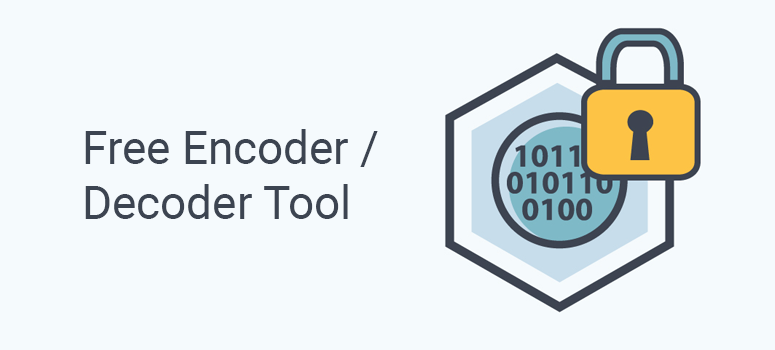How Does Our URL Encoder & Decoder Tool Work?
Our URL Encoder & Decoder tool makes it super easy to encode or decode your URLs. Here’s how it works.
- Choose between the Encoder or Decoder tab
- Specify the URL you want to encode or decode
- Then hit the Encode or Decode button
After hitting the button, you can find the output just below the Encode & Decode tool.
What is URL Encoding / Decoding?
When you transmit information through a URL, you need to ensure that it only uses specific allowed character set, known as ASCII (American Standard Code for Information Interchange) character set.
Since URLs often contain characters outside the ASCII set, they have to be converted into a valid ASCII format. This is where URL encoding comes in.
URL encoding, which also known as percent-encoding, is the process of converting characters in a URL into ASCII characters.
ASCII is a character set containing 128 characters, including the number from 0-9, the upper and lower case English letters, and some special characters.
URL encoding lets you replace unsafe characters with a “%” followed by two hexadecimal digits. For example, if your URL includes spaces, the encoding process replaces it with a plus (+) sign or with %20.
What Should be Encoded?
All non-ASCII characters in a URL that are being used outside its normal context need to be encoded. Let’s take a look at a few common characters in a URL and their encoding.
| Character | URL Encoded |
|---|---|
| ; | %3B |
| ? | %3F |
| / | %2F |
| : | %3B |
| # | %23 |
| & | %24 |
| = | %3D |
| + | %2B |
| $ | %24 |
| < space > | %20 or + |
| % | %25 |
If you transmit data using the GET method, then you’ll need to encode the data as it will be sent over the URL. For instance, if you are writing a clickable link to promote your post on Facebook or promote an RSS feed, then your URL will need to be encoded.
How Do URL Encoder/Decoder Tools Work?
There are so many online URL encoder/decoder tools available, which can be used to easily encode or decode a URL string. These tools are often simple to use, with a user-friendly interface. Users input the text to be encoded or decoded, and then the tool generates the encoded or decoded output.
Encode/decode URL tools typically adhere to various specifications and standards, such as RFC 1738, which defines the syntax and semantics of URLs.
These online tools may also use specific character encoding methods, such as UTF-8 – a popular character encoding format that can represent all possible characters in the Unicode standard.
Encoded data can be transmitted over the internet using various HTTP methods, such as GET and POST, and can also be included in the query string of a URL. The query string is a part of the URL that contains data that is to be passed to the server when a request is made, and is often used to transmit form data or other parameters.
Interoperability must be kept in mind when using URL encoder/decoder tools, as it ensures that the encoded or decoded data can be correctly interpreted by other software or systems. This involves adhering to standards and specifications for character encoding, newline characters, whitespace handling, IP addresses, and other related factors.
Overall, URL encoder/decoder tools are essential for ensuring that data can be transmitted securely and accurately over the internet, and that it can be correctly interpreted by various software and systems.
Now go ahead and use our URL encoder/decoder tool anytime you need.
FAQs on Encoding and Decoding URLs
What is URL encoding?
URL encoding is a process of converting a string of text into a format that can be safely transmitted over the internet. It replaces reserved characters, such as spaces and special characters, with their corresponding percent-encoded hexadecimal value.
What is URL decoding?
URL decoding is the opposite of URL encoding, and involves converting a percent-encoded string of text back into its original form. This is used when handling data that has been encoded for transmission over the internet.
What is an encoder/decoder?
An encoder/decoder, also known as a codec, is a program or algorithm that is used to convert data from one format to another. In the case of URL encoding and decoding, the encoder/decoder tool is used to convert between a string of text and its percent-encoded form.
What is the HTML character set?
This is a system of assigning unique codes to each character in a given language. It lets web browsers display text correctly, even if the language uses characters that are not part of the ASCII character set.
What is the difference between a URL and a URI?
A Uniform Resource Locator (URL) is a specific type of Uniform Resource Identifier (URI) that specifies the location of a resource on the internet. A URI is a broader term that encompasses other types of identifiers, such as URNs (Uniform Resource Names), which are used to identify resources by name rather than by location.
What is the x-www-form-urlencoded format?
The x-www-form-urlencoded format is a common way to encode data that is submitted via an HTML form or as part of an HTTP request. It involves encoding each parameter and its corresponding value as a key-value pair separated by an equals sign, with each pair separated by an ampersand.
What is the purpose of URL encoding in HTTP requests?
URL encoding is necessary in HTTP requests because some characters have special meanings in the context of a URL, such as the ampersand and question mark. By encoding these characters using percent-encoding, they can be safely transmitted over the internet without interfering with the structure of the URL.
What is the MIME type of a resource?
The MIME type of a resource, also known as the media type, is a label that is used to identify the format of a file or other data that is being transmitted over the internet. This allows web browsers and other software to properly interpret the data and display it in the appropriate format.
What are unreserved characters?
Unreserved characters are characters that have no special meaning; they can be displayed as-is and require no special handling. These include uppercase and lowercase letters ( A-Z , a-z ), decimal digits ( 0-9 ), hyphen ( – ), period ( . ), underscore ( _ ), and tilde ( ~ ).
That’s all we have for you. You may want to read our related posts:
- WPCode Review: The Best Way to Add Custom Code to WordPress
- How to Create UTM Codes to Track Your URLs in WordPress
- 5 Best WordPress URL Shorteners
- How to Cloak Affiliate Links in WordPress (the Easy Way)
These posts help you cloak URls and use custom coding on your website.







